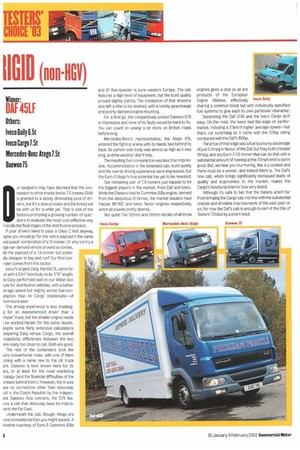D (non-HOY) Winner:
Page 26

If you've noticed an error in this article please click here to report it so we can fix it.
OAF 45LF
Others: Iveco Daily 6.5t Iveco Cargo 7.51 Mercedes-Benz Atego 1.51 Daewoo 75
or lawgivers may have decreed that the concession to drive trucks below 7.5 tonnes GVW is granted to a slowly diminishing pool of drivers, but it's a slow process and the breed will be with us for a while yet. That is one of the factors prompting a growing number of operators to evaluate the most cost-effective way r handle the final stages of the distribution process.
If your drivers need to pass a Class C test anyway, aybe you should go for the 'extra payload in the same aad space combination of a 12-tonner. Or why not try a rge van-derived vehicle around six tonnes, ith the payload of a 7.5-tonner but potenally cheaper to buy and runP Our first confider comes from this sector.
Iveco's largest Daily, the 65C15, came For ist with a 23ur3 box body on its In" length. le Daily performed well on our Welsh test iute for distribution vehicles, with a better terage speed but slightly worse fuel con'motion than its Cargo stablemate—of hich more later.
The driving experience is less chaiiengg for an inexperienced driver than a roper' truck, but the smaller engine needs
be worked harder for the same results. espite some fairly extensive calculations amparing Daily versus Cargo, the overall -oductivity differences between the two ere really too close to call. Both are good.
The rest of the contenders took the lore conventional route, with one of them aming with a name new to the UK truck ark. Daewoo is best known here for its arc, or at least for the novel marketing :rategy (and the financial difficulties of the preens behind them). However, the trucks ave no connection other than historical. uilt in the Czech Republic by the indepenent Daewoo Ada concern, the D75 fearres a cab that obviously owes its inspiraon to the Far East.
Underneath the cab, though, things are lore conventional than you might expect. A riveline courtesy of Euro-3 Cummins ISBe and ZF five-speeder is pure western Europe. The cab features a high level of equipment, but the build quality proved slightly patchy. The installation of that driveline also left a little to be desired, with a notchy gearchange and poorly-damped engine mounting.
For a first go, the competitively-priced Daewoo D75 is impressive and none of its faults would be hard to fix. You can count on seeing a lot more on British roads before long.
Mercedes-Benz's representative, the Atego 818, entered the fighting arena with its hands tied behind its back. Its curtain-side body was almost as high as it was long, and the weather didn't help.
The resulting fuel consumption was less than impressive. Accommodation in the extended cab, build quality and the overall driving experience were impressive, but the Euro-3 Atego's true potential has yet to be revealed.
Our remaining pair of 7.5-tonners just happen to be the biggest players in the market, from Daf and Iveco. While the Daewoo had its Cummins ISBe engine, derived from the ubiquitous B-Series, the market leaders have Paccar BE110C and Iveco Tector engines respectively, which all sounds pretty diverse.
Not quite! The 102mm and 120mm stroke of all three
engines gives a clue as all are products of the European Engine Alliance, effectively lye" Daily
sharing a common block but with individually-specified fuel systems to give each its own particular character.
Separating the Daf LF45 and the Iveco Cargo isn't easy. On the road, the Iveco had the edge on performance, including a 2:Ikm/h higher average speed—but that's not surprising as it came with the 170hp rating compared with the Daf's 150hp.
The price of that edge was a fuel economy advantage of just 0.3mpg in favour of the Daf, but they both cracked 19mpg, and any Euro-3 7.5-tonner that can do that with a substantial amount of running at the 70mph limit is damn good. But, we hear you murmuring, this is a contest and there must be a winner: and indeed there is. The Dafs new cab, which brings significantly increased levels of quality and ergonomics to the market, makes the Cargo's functional interior look very dated.
Although it's safe to bet that the Italians aren't far from bringing the Cargo cab into line with the substantial chassis and driveline improvements of the past year or so, for now the Daf's cab is enough to earn it the title of Testers' Choice by a short head.




























































































































































